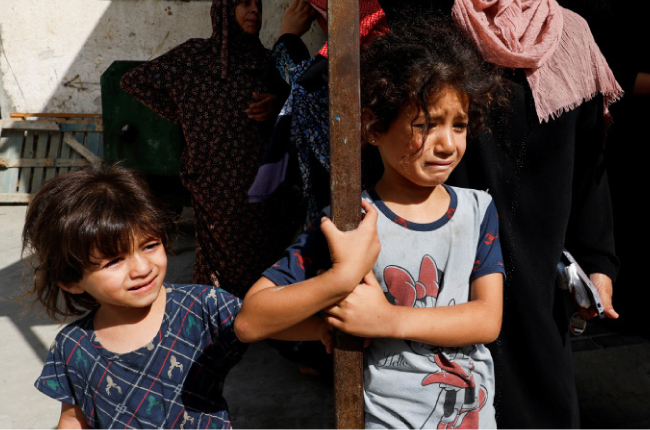War destroys communities and families and often disrupts the development of the social and economic fabric of nations. There is no doubt that the populations in war and conflict situations should receive mental healthcare as part of the total relief, rehabilitation and reconstruction processes. Palestinians have long reported trauma from living in occupied Palestinian territories. The war’s impact is largely measured by the number of physical injuries and deaths, with 34,000 Palestinians killed so far.
The long-standing Israeli–Palestinian conflict has escalated since the beginning of the 20th century, resulting in a humanitarian crisis in Palestine. It has caused significant psychological and social suffering, particularly children and young people. Among the consequences of war, the impact on the mental health of the civilian population is one of the most significant. Studies show a definite increase in the incidence and prevalence of mental disorders, globally where wars were fought. Women are more affected than men.
Other vulnerable groups are children, the elderly and the disabled. Refugees who have fled from war zones are at significantly increased risk for post-traumatic stress syndrome (PTSD) and other trauma-related disorders, which may lead to dysfunctional behaviours that impair their ability to cope with social and/or family life. A large segment of the Palestinian population has become accustomed to a wide range of social and psychological shocks as a part of their immediate environment.
Origins of ‘Shell shock’
By the winter of 1914–15, ‘Shell shock’ had become a pressing medical and military problem. Not only did it affect increasing numbers of frontline troops serving in World War I, British Army doctors were struggling to understand and treat the disorder. The battles were over, but the soldiers still fought. Flashbacks, nightmares, and depression plagued them. Some slurred their speech. Others couldn’t concentrate. Haunted and fearful, the soldiers struggled with the ghosts of war. Shell shock took the British Army by surprise. In an effort to better understand and treat the condition, the Army appointed Charles S. Myers, a medically trained psychologist, as consulting psychologist to the British Expeditionary Force.
Along with William McDougall, another psychologist with a medical background, Myers argued that shell shock could be cured through cognitive and affective reintegration. Myers and McDougall believed a patient could only be cured if his memory were revived and integrated within his consciousness. Nearly 1.4 million of the 16.1 million men who served in World War II were treated for combat fatigue during the war, and the condition was responsible for 40 percent of all discharges.
Scarred emotions
In every theatre of armed conflict internationally, appropriate parties assuming responsibility for atrocities and the implementation of local mechanisms for reconciliation are crucial. Some typical civilian stressors include life threat; being bombed, shot at, threatened, or displaced; being confined to one’s home; losing a loved one or family member; suffering from financial hardships; and having restricted access to resources such as food, water, and other supplies. Particularly horrific stressors experienced by some civilians during war include torture, beatings, rape and witnessing sexual abuse of or violence toward a family member- across the world’s theatres of war.
Complex emergencies are often characterized by extensive violence and loss of life, massive displacement of people, widespread damage to societies and economies, the need for large-scale, multifaceted humanitarian assistance, and obstructions to such assistance by political and military constraints.
Psychiatric and psychological studies have shown that war leaves enduring episodes in children and adolescents. During the war, children face (to differing degrees) exposure to two types of traumatic events: type I (sudden traumatic event) and type II (protracted exposure to adverse events resulting in dysfunctional coping mechanisms). As a result, they suffer from conditions such as anxiety disorders, Post-Traumatic Stress Disorder (PTSD), depression, dissociative disorders (disengagement in the external world, depersonalization, derealization), behavioral disorders (especially aggression, a social and violent criminal behaviour), and alcohol and narcotic substance abuse. Globally, many refugee children have already been traumatized in their country of origin, by war-related events, and many have been exposed to life-threatening situations during their flight to freedom, towards kind nations giving them asylum and hope.
Moving forward
The United Nations Children’s Fund has stated that ‘time does not heal trauma’ for millions of such children, who are often described as a ‘lost generation’. The task that faces victims of war and atrocity is often spoken of as a ‘healing’ or ‘processing’ (of traumatic experience), ‘acceptance,’ and coming to terms with the past. Human rights and health cannot be separated in psychotherapy with survivors of war. When assessing trauma and mental health symptoms in refugee children, providers should attend to engagement and cultural considerations as important first steps.
Today, the total refugee population registered with UNRWA numbers over 5 million, living in 58 refugee camps in Jordan, Lebanon, Syria, the Gaza Strip, and the West Bank, including East Jerusalem.The situation in Gaza has reached a critical juncture, with civilians enduring relentless violence; continuous bombardment; severe lack of food.
Palestine’s economy and its capacity to create jobs have been devastated, resulting in the impoverishment and de-development of a highly skilled and well-educated society. In 2020, the average unemployment rate stood at 49 %—one of the highest in the world. Access to clean water and electricity remains at crisis level and impacts nearly every aspect of life. Israeli military attacks, blockades, and widespread hopelessness have led to a humanitarian crisis in Gaza, with significant adverse effects on children and young people’s mental health. Palestinian youth face significant barriers to accessing mental health services, including a shortage of mental health professionals, limited funding and restrictions on movement.
Perhaps viewing this situation through the prism of human rights violations and their grave impact on mental health might prompt the international community to pressure Israel to act. Palestinians and Israelis both deserve security and protection from trauma. Innocent civilians in Palestine and Israel- deserve peace and healing for their minds.
By-Dishan Joseph






